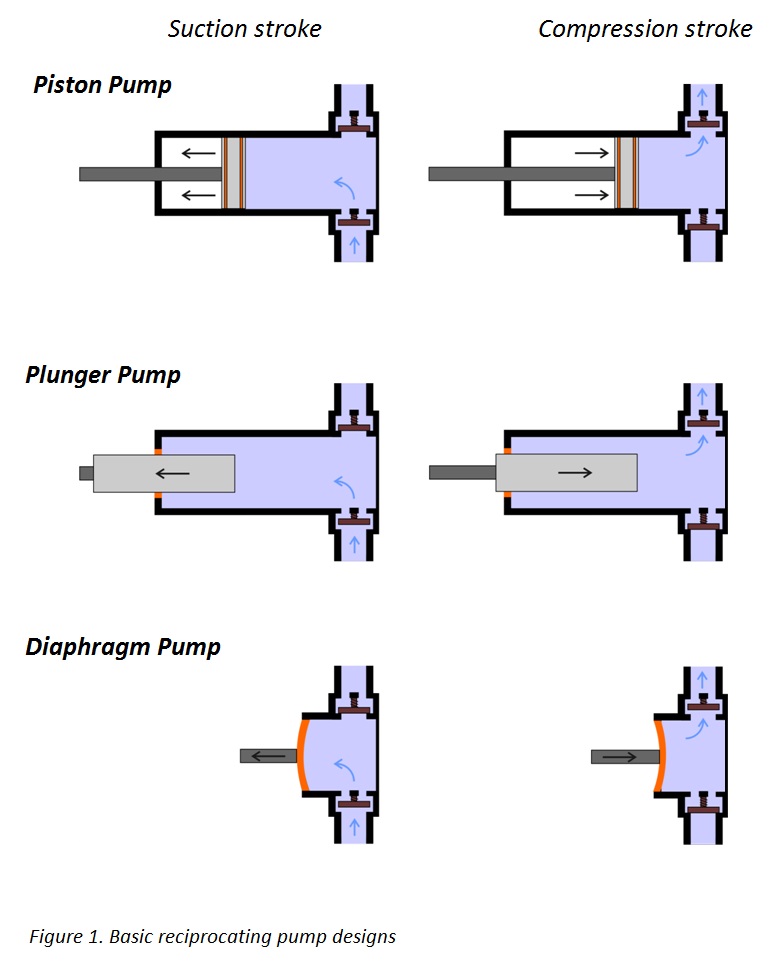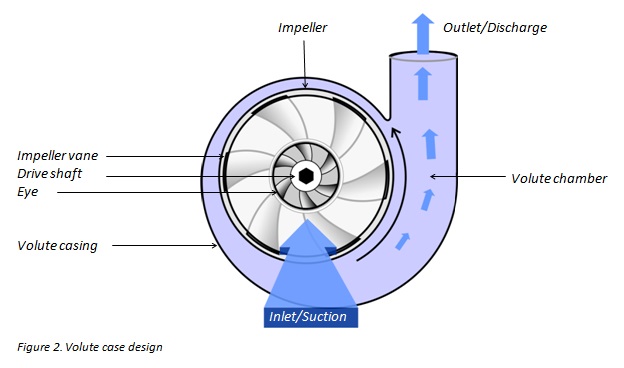Pumps
Table of Contents
What are Pumps?
Pumps are devices that are focused on the movements of fluid (gases or liquids). Pumps can come in many different sizes and specifications, ranging in purpose and scale from near microscopic pumps that move extremely precise amounts of fluids, to large industrial pumps that transfer mass amounts of fluids every second [1]. Pumps typically have a reciprocating or rotary mechanism that performs the mechanical work on the fluids to move them [1].
Positive-Displacement and Nonpositive-Displacement
There are two main categories for pumps, positive-displacement and nonpositive-displacement, that share some common traits while having unique methods [1]. While the primary focus of both types of pumps is to transfer fluids to a desired location, they operate under very different principles and mechanics. Positive-displacement pumps move the fluids by repeatedly enclosing a fixed volume and then mechanically moving that volume through the system and out the output valves [2]. Nonpositive-displacement pumps work by adding kinetic energy to the fluid, thereby increasing the fluid's velocity and moving the fluid through the pump [3]. Because of these different mechanisms for moving the fluids, the pumps work most effectively under different sets of conditions, the following table highlights some of the most significant differences in pumps and may help in choosing the appropriate type for a given application [3].
Key Differences in Positive-displacement and Nonpositive-displacement Pumps [3]
| Characteristic | Positive-Displacement Pumps | Nonpositive-Displacement Pumps |
|---|---|---|
| Pressure | Work in high pressure applications, up to 800 bar (80,000 kPa) | Used for low pressure applications, maximum pressure of 18 to 20 bar (1,800 to 2,000 kPa) |
| Efficiency | Efficiency increases with increasing pressure | Efficiency peaks at best-efficient-point. At higher or lower pressures, efficiency decreases |
| Viscosity | Efficiency increases with increasing viscosity | Efficiency decreases with increasing viscosity due to frictional losses inside the pump |
| Performance | Flow is constant with changing pressure | Flow varies with changing pressure |
Examples of Positive-Displacement Pumps [2] | A Centrifugal Pump (Nonpositive Displacement) [2] |
|---|---|
Pump Specifications
All pumps have a series of specifications meant to indicate the capabilities and power of the pump. While there are many differences between pumps, some of the key points to consider when selecting a pump are the net positive suction head (NPSH), priming, flexibility, corrosion, useful life, maintenance requirements, quantity pumped, pumping head, and the power source [4].
Net Positive Suction Head
The NPSH is the minimum amount of energy in the water needed at the pumps inlet, this is determined by the manufacturer. The available NPSH is the available energy in the water, which must be determined based on the specific piping system [4]. An estimate can be approximated for a simple system using the following equation [4]:
(atmospheric pressure - vapor pressure) / 2.3 - height from the water level to the pump - friction loss in the pipes
For more information on calculating the available NPSH, see [5].
Priming
Priming a pump is the process of removing air from the inside and the suction line, without priming, pumps may cease to function and break down [4]. Some pumps are self-priming, meaning this process does not need to be done on them and may save some time at certain points in operation. In principle, all positive displacement pumps are self-priming, however in practice a pump may overheat or the seals used could be slightly worn, causing issues [6]. It is best to check the manufacturer's data sheet if the pump is self-priming, if the information is not listed assume that the pump must be primed.
Pumping Head
Pumping head, often referred to as just "head", measures how high a given pump could lift water up [7]. It is usually measured in feet or meters, and it is a combination of multiple factors, such as how much pressure the pump can output, the fluid flow rate of the pump, and the height of the fluid in the intake tank [7]. The total head (Ht) is the discharge head (Hd) subtracted by the suction head (Hs), Ht = Hd - Hs [7]. The given information with the data sheet is the total head, however often times the discharge head is the important factor as that determines how far a pump can push the fluid, thus discharge head must be calculated with the total head and the suction head. Once the total head is reached in the pipe, the pump can no longer produce any fluid flow. Similarly the fluid flow and the total head are inversely proportional, as the total head goes down for a pump the flow rate of that pump increases, up to a certain point at the minimum head [7].
| Meaning of Head [7] | Total Head vs. Discharge and Suction Head [7] | Head vs. Flow Graph for a Centrifugal Pump [7] |
|---|---|---|
References
Contributors:
| User | Last Update |
|---|---|
| Former user (Deleted) | 1423 days ago |
| Former user (Deleted) | 1424 days ago |
| Former user (Deleted) | 1425 days ago |




